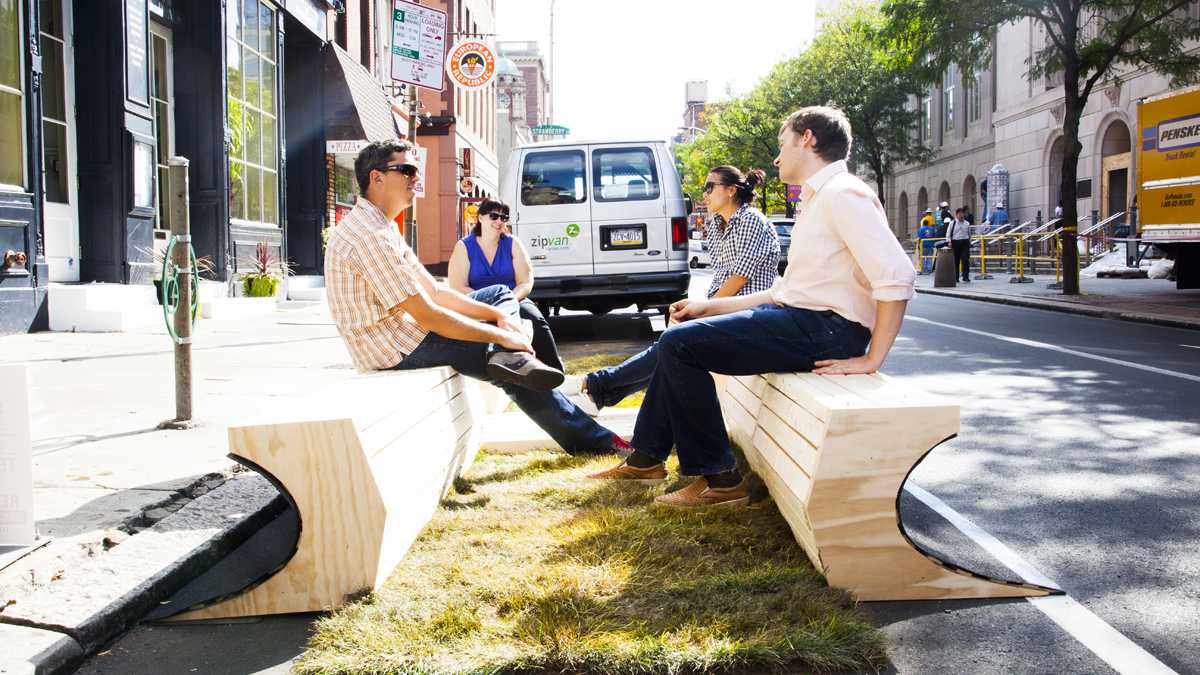Author interview: Tactical Urbanism
Listen
People sit at a 'parklet,' a parking spot converted into mini-park, on 3rd Street and Market Street in Philadelphia. (Brandon Reynolds/for NewsWorks)
Across the country, people—and cities—are reinventing public spaces with temporary, low-cost projects.
Building anything new in a city takes a long time. There are zoning rules, permits, public hearings: layers and layers of government bureaucracy.
So across the country, people, and even cities, are starting to bypass some of the red tape and just…build things.
Residents are turning parking spaces into mini-parks for a day. Or spray-painting new bike lanes in the middle of the night. City agencies are using licensing loopholes to create temporary beer gardens in vacant lots.
These are all examples of what’s called tactical urbanism: an approach that favors low-cost, temporary projects as a way to spark long-term change in a public space.
The goal is to make the space safer, more bikeable, more walkable, more hospitable to business, or just more fun.
We spoke with Mike Lydon, a city planner who’s the co-author of a book called Tactical Urbanism.
Can you share some examples of tactical urbanism projects in Pennsylvania?
There’s a number of projects in the city of Philadelphia. There are temporary beer gardens and pop-ups that are happening to activate spaces. As a more rural example, there was a man in a smaller town in Pennsylvania and he was very tired of speeding cars on main street and wanted to slow people down. So he took it upon himself to write a big 25 mile per hour sign on the asphalt in front of his store. Unfortunately he was arrested. That sort of arrest is generally pretty rare in this movement but it does happen from time to time. (Editor’s note: That man, John Cherok II, faced a fine of about $540, according to the Observer-Reporter).
Some examples of tactical urbanism are not only not really sanctioned by the city, but they’re actually illegal. What are the reactions cities tend to have?
They tend to freak out, in the short term, to be honest. But more and more cities see the intent behind these projects, understanding they oftentimes are consistent with adopted policies or plans, and they embrace the idea and find ways to scale them up or adopt them more formally.
In the book you wrote that sometimes city officials actually launch these temporary, low-cost projects to get around red tape within their own agencies. So that means tactical urbanism can start with the city too, right?
Yeah, that’s right. We see a lot of that happening now, which is really exciting. It’s a market study, so to speak. It shows what uses are going to be popular and will draw people. And the best part about this is if your project fails, you haven’t spent a lot of money and you haven’t spent a lot of time hopefully. You’ve figured out what works and what doesn’t work through a kind of scientific method, and you’ve just applied it to the built environment.
You also wrote in the book that tactical urbanist techniques can help a city bypass NIMBY-ism, the affliction where every resident who shows up at planning meetings says “not in my backyard.”
In my experience as a professional planner, we’ve done hundreds and hundreds of public meetings and find that there’s a very similar kind of person who shows up to these meetings. They tend to be a little bit older, they tend to be wealthier, they tend to be highly educated, and they tend to be conservative about the rate of change in a neighborhood. Those voices that come out to a meeting at 6:30 on a Tuesday night do not represent oftentimes the majority of people living in a neighborhood or a city.
If we actually include demonstration projects as part of the public process, then we’re able to meet people where they already are in their daily lives. It remains a whole lot less abstract, and it doesn’t require somebody taking time out of their very busy schedule. I think that’s particularly important for people who are working very long hours, or working multiple shifts, and they just don’t have time or even the interest to be involved civically in the decisions that get made at the city level that also impact them.
What are the limitations to this approach, when it comes to revitalizing a city?
There are a lot of them. I mean, it won’t tackle every equity issue. It’s not going to build us new rail lines and deal with big infrastructure challenges. It’s really well-suited and well-scaled for more neighborhood concerns. Of course it can have a bigger impact when the city gets a hold of these ideas and makes the changes at that level, but really the initial intent is to create change where we notice it most, which is in our neighborhoods and at the block and street scale, building scale.
Another limitation is who is doing these tactical urbanism projects. Who can feel comfortable going out in the middle of the night and doing something that’s technically illegal and get away with it? In that I think you have a lot of cultural and race and class challenges that tactical urbanism cannot fully overcome. I wish it could solve that, but it doesn’t.
Tactical Urbanism was written by Mike Lydon and city planner Anthony Tepedino Garcia. The co-authors run an urban planning, design, and research-advocacy firm called Streets Plan Collaborative.
WHYY is your source for fact-based, in-depth journalism and information. As a nonprofit organization, we rely on financial support from readers like you. Please give today.



